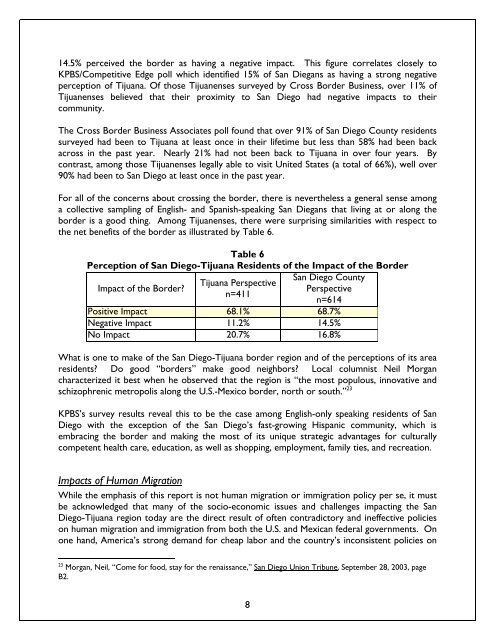Blurred Borders - International Community Foundation
Blurred Borders - International Community Foundation
Blurred Borders - International Community Foundation
You also want an ePaper? Increase the reach of your titles
YUMPU automatically turns print PDFs into web optimized ePapers that Google loves.
14.5% perceived the border as having a negative impact. This figure correlates closely to<br />
KPBS/Competitive Edge poll which identified 15% of San Diegans as having a strong negative<br />
perception of Tijuana. Of those Tijuanenses surveyed by Cross Border Business, over 11% of<br />
Tijuanenses believed that their proximity to San Diego had negative impacts to their<br />
community.<br />
The Cross Border Business Associates poll found that over 91% of San Diego County residents<br />
surveyed had been to Tijuana at least once in their lifetime but less than 58% had been back<br />
across in the past year. Nearly 21% had not been back to Tijuana in over four years. By<br />
contrast, among those Tijuanenses legally able to visit United States (a total of 66%), well over<br />
90% had been to San Diego at least once in the past year.<br />
For all of the concerns about crossing the border, there is nevertheless a general sense among<br />
a collective sampling of English- and Spanish-speaking San Diegans that living at or along the<br />
border is a good thing. Among Tijuanenses, there were surprising similarities with respect to<br />
the net benefits of the border as illustrated by Table 6.<br />
Table 6<br />
Perception of San Diego-Tijuana Residents of the Impact of the Border<br />
Impact of the Border?<br />
Tijuana Perspective<br />
n=411<br />
San Diego County<br />
Perspective<br />
n=614<br />
Positive Impact 68.1% 68.7%<br />
Negative Impact 11.2% 14.5%<br />
No Impact 20.7% 16.8%<br />
What is one to make of the San Diego-Tijuana border region and of the perceptions of its area<br />
residents? Do good “borders” make good neighbors? Local columnist Neil Morgan<br />
characterized it best when he observed that the region is “the most populous, innovative and<br />
schizophrenic metropolis along the U.S.-Mexico border, north or south.” 23<br />
KPBS’s survey results reveal this to be the case among English-only speaking residents of San<br />
Diego with the exception of the San Diego’s fast-growing Hispanic community, which is<br />
embracing the border and making the most of its unique strategic advantages for culturally<br />
competent health care, education, as well as shopping, employment, family ties, and recreation.<br />
Impacts of Human Migration<br />
While the emphasis of this report is not human migration or immigration policy per se, it must<br />
be acknowledged that many of the socio-economic issues and challenges impacting the San<br />
Diego-Tijuana region today are the direct result of often contradictory and ineffective policies<br />
on human migration and immigration from both the U.S. and Mexican federal governments. On<br />
one hand, America’s strong demand for cheap labor and the country’s inconsistent policies on<br />
23<br />
Morgan, Neil, “Come for food, stay for the renaissance,” San Diego Union Tribune, September 28, 2003, page<br />
B2.<br />
8















